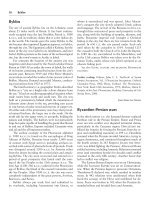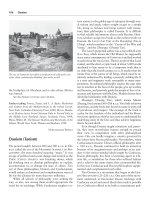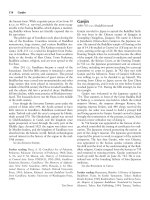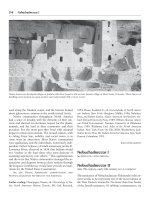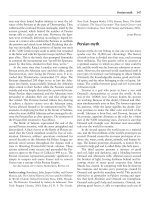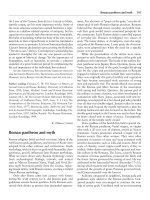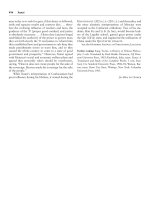Encyclopedia of world history (facts on file library of world history) 7 volume set ( PDFDrive ) 145
Bạn đang xem bản rút gọn của tài liệu. Xem và tải ngay bản đầy đủ của tài liệu tại đây (147.41 KB, 1 trang )
106
Daoism
The city of Damascus lies within a fortification of walls and is one
of the oldest continuously inhabited cities in the world.
the birthplace of Abraham and is also where Moses
was buried.
See also Syriac culture and church.
Further reading: Fawaz, Tarazi, and C. A. Bayly. Modernity
and Culture from the Mediterranean to the Indian Ocean.
New York: Columbia University Press, 2002; Ma’oz, Moshe,
et al. Modern Syria: From Ottoman Rule to Pivotal Role in
the Middle East. Portland: Sussex Academic Press, 1999;
Weiss, Walter M. The Bazaar: Markets and Merchants of the
Islamic World. New York: Thames and Hudson, 1998.
Nurfadzilah Yahaya
Daoism (Taoism)
The period roughly between 600 and 300 b.c.e. in China is called the era of the Hundred Schools of Philosophy, the term hundred meaning “many.” It was
an age of political and social change and turmoil as the
Zhou (Chou) dynasty was breaking down, which
led thinking men to develop philosophies to explain,
accommodate to, or change the state of affairs. Two
out of these philosophies, Daoism and Confucianism,
would endure as dominant and complementary ways of
life for the Chinese for more than two millennia.
While all schools of philosophy were seeking the
way, or dao, one among them would appropriate the
word for its teachings. While Confucians sought to re-
turn society to the golden age of antiquity through moral reform and study, others sought escape to a simple
life, living as recluses and being content with nonaction; their philosophy is called Daoism. It is difficult
to find reliable information about early Daoism. However, scholars accept two books as the earliest works on
Daoism: the Laozi (Lao Tzu) or the Daodejing (Tao-te
Ching), which translates as the “Canon of the Way and
Virtue,” and the Zhuangzi (Chuang Tzu).
The Laozi’s purported author was a man called Laozi
(Lao Tzu), which means the Old Master; he supposedly
was a senior contemporary of Confucius and had worked
as archivist at the royal court. There is no proof that Laozi
existed, and the short, cryptic book of about 5,000 words
attributed to him seems to be a composite work that is
no older than the fourth century b.c.e. It teaches that the
mystic Dao is the source of all being, which must be intuitively understood by leading a passively yielding life. It
is a terse and enigmatic work susceptible to many interpretations. Its political philosophy teaches the sage ruler
not to interfere in the lives of the people, give up warfare
and luxuries, and passively guide the people to lives of innocence and harmony with the Dao. Modern laissez-faire
ideals find similarities with Daoism.
Zhuangzi (Chuang Tzu), which means Master
Zhuang, lived around 369–286 b.c.e. Very little is known
about him, and the book that bears his name is witty, full
of paradoxes and imagery. The message of the book is
a plea for the freedom of the individual and his liberation from egotism so that he can come to understand the
underlying unity of the Dao and thus achieve happiness
that is beyond death.
Even though Daoists taught nonaction and passivity, they were nevertheless human enough to preach
their view in competition with other philosophical
views. One can hardly imagine a country governed by
the laissez-faire Daoist philosophy. Nevertheless, when
Confucianism became China’s official philosophy after
c. 100 b.c.e., Daoism continued to hold its attraction
because of its imaginativeness and perhaps as an antidote to the serious-minded ideals taught by Confucius.
Daoist philosophy has been a leavening agent in Chinese life, a consolation for those who suffered failures
and a relief to the many duties that circumscribed life.
In this way Confucian and Daoist philosophies supplemented and complemented each other.
Neo-Daoism is a movement that began in the Eastern Han dynasty (25–220 c.e.). One part of this movement undertook to harmonize Daoist teachings with
Confucian social and moral ideals that made it possible
for a Confucian official to be both a conscientious pub-

